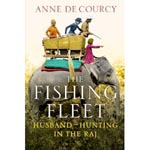Book Review: The fishing fleet: Husband hunting in The Raj
John Ure enjoys a remarkable tale of females setting sail to India to secure a husband


To order any of the books reviewed or any other book in print, at
discount prices* and with free p&p to UK addresses, telephone the Country Life Bookshop on Bookshop 0843 060 0023. Or send a cheque/postal order to the Country Life Bookshop, PO Box 60, Helston TR13 0TP * See individual reviews for CL Bookshop price.
The Fishing Fleet: Husband-Hunting in the Raj
Anne de Courcy
(Weidenfeld & Nicolson, £20, *£16)
The idea of a ‘fishing fleet' of young ladies, some of them former debutantes, setting sail for British India to try to find the husbands they had failed to secure at home, may seem at first sight either rather hilarious or rather despicable. But as this entertaining book makes clear, it was a serious and productive venture, both for the young ladies concerned and for the frustrated male servants of the Raj, who, right up to the time of air travel and particularly before the opening of the Suez Canal, spent years away from home in a land where courting a local girl was considered disgraceful, career-damaging and betraying the imperial image.
Admittedly, in the days before the Raj took over from the East India Company after the Mutiny, things had been a little easier for the British bachelors -Indian mistresses had been widely acquired and even Indian wives accepted-but in the century between 1857 and 1947 (the main time span of this book), until the arrival of the fishing fleet, sport-especially polo-seemed to have replaced sex as the outlet for the vigorous and lonely.
Exquisite houses, the beauty of Nature, and how to get the most from your life, straight to your inbox.
Anne de Courcy paints a broad picture of life in the Raj: the rigid social hierarchies, with officers in smart cavalry regiments and members of the exclusive Indian Civil Service at the top and trading ‘boxwallahs' near the bottom; the glittering lifestyle of the Indian princes with their jewels, palaces and polo ponies; the loneliness of children sent ‘home' to England for an education that separated them from their parents for years at a time; the rigidly racially exclusive country clubs; the splendour of Viceregal Delhi, which outshone the Courts of successive British monarchs from Victoria to George VI; the integrity of the administrators, who would only receive gifts that were consumable-Champagne, foie gras, scent-and not, for instance, a silver salver that had to be promptly returned to the donor; the perils of ‘snakes, floods, riots... panthers in the garden and inexplicable fevers'; the flirtatious life at the hill stations, where wives would often be unaccompanied by their husbands. Against this hot-house background, many of the stories of Lord Curzon's durbars and other memorable events are retold with zest and humour.
As for the girls of the fishing fleet themselves, many of them felt they were ‘on the shelf' in England by 22. In India, on the other hand, they were surrounded by eligible young (or fairly young -marriage before 30 was frowned upon) men, who appeared briefly between postings to frontier service or other distant duties, and the men knew that if they did not make their proposals quickly, the girls would be snapped up by other eager bachelors. Speedy decisions were the order of the day for both sides: again and again, the author tells of engagements following the briefest encounters. She draws on memoirs, diaries and letters to fill out individual stories.
Few of the girls came home rejected as ‘returned empties'.Their stories are a perfect read for a cruise ship sailing eastwards or a deckchair in the sun.
* Summer
Subscriptions Sale - Save £55 a year
Country Life is unlike any other magazine: the only glossy weekly on the newsstand and the only magazine that has been guest-edited by His Majesty The King not once, but twice. It is a celebration of modern rural life and all its diverse joys and pleasures — that was first published in Queen Victoria's Diamond Jubilee year. Our eclectic mixture of witty and informative content — from the most up-to-date property news and commentary and a coveted glimpse inside some of the UK's best houses and gardens, to gardening, the arts and interior design, written by experts in their field — still cannot be found in print or online, anywhere else.
